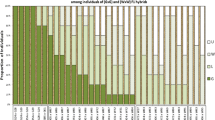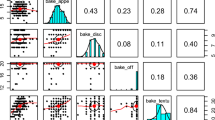Abstract
Replicated experiments with various potato cultivars having diverse tuber skin types demonstrated that the Halderson periderm shear tester was sufficiently sensitive to measure genotypic and phenotypic differences in skin-set (periderm maturity). All genotypes had lower skin-set readings at the bud end of the tuber compared to the equatorial region and stem end. The technique employed with the shear tester objectively resolved genotypic differences in the developmental time courses for skin-set and clearly showed that the periderm of Russet Burbank tubers matured more rapidly than the periderm of other cultivars with smooth skin types. However, a consistent relationship between periderm weight and skin-set could not be established. In postharvest experiments designed to describe the phenotypic effect of temperature and relative humidity on tuber periderm maturation, we found that high relative humidity retarded the development of skin-set. The ability to detect genotypic and phenotypic differences with this technique for measuring skin-set indicates that it is feasible to further develop a standardized procedure suitable for testing diverse skin types in breeding and certified seed programs as well as for use by growers of table stock, seed, and chipping potatoes.
Compendio
Experimentes con repeticiones, con varios cultivares de papa con tubérculos de diversos tipos de piel, demostraron que el probador Halderson de corte de periderma era suficientemente sensible para medir las diferencias genotípicas y fenotípicas en el establecimiento de la piel (madurez del periderma). Todos los genotipos tuvieron lecturas menores de establecimiento de la piel en el extremo apical del tubérculo en comparación con la región ecuatorial y el extremo basal. La técnica empleada con el probador de corte resolvió objetivamente las diferencias genotípicas en los periodos de desarrollo para el establecimiento de la piel y mostró claramente que el periderma de los tubérculos de Russet Burbank madura más rápidamente que el periderma de otros cultivares con tipos lisos de piel. Sin embargo, no se pudo establecer una relatión consistente entre el peso del periderma y el establecimiento de la piel. En experimentos de poscosecha, diseñados para describir el efecto fenotípico de la temperatura y de la humedad relativa sobre la maduración del periderma del tubérculo, se encontró que una alta humedad relativa retarda el desarrollo del establecimiento de la piel. La capacidad para detectar las diferencias genotípicas y fenotípicas con esta técnica, para medir el establecimiento de la piel, indica que es factible desarrollar en el futuro un procedimiento estándar apropiado para probar diversos tipos de piel en los programas de mejoramiento y certificatión de semilla al igual que para su utilizatión por los productores de papa para consumo directo, semilla y papas fritas a la inglesa.
Similar content being viewed by others
Literature Cited
Appleman, C.O., W.D. Kimbrough and C.L. Smith. 1928. Physiological shrinkage of potatoes in storage. Bull. 303. U. of Maryland Agr Exp Sta 159–175.
Halderson, J.L. 1989. Potato tuber response to vine killing. ASAE Paper No. 89-6622. St. Joseph, MI 48085–9659.
Halderson, J.L. and Henning, R.C. 1993. Measurements for determining potato tuber maturity. Am Potato J 70:131–141.
Kunkel, R. and W.H. Gardner. 1965. Potato tuber hydration and its effect on blackspot of Russet Burbank potatoes in the Columbia Basin of Washington. Am Potato J 42:109–124.
Lulai, E.C. 1990. Tuber wound-healing measurements and observations. European Assoc for Potato Res Abst of the 11th Triennial Conference. pp.499.
Lulai, E.C. 1991. Vapor conductance measurements of suberizing potato tubers. Am Potato J 68:623.
Lulai, E.C. and Morgan, W.C. 1992. Histochemical probing of potato periderm with neutral red: a sensitive cyto-fluorochrome for the hydrophobic domain of suberin. Biotechnic and Histochemistry 67:185–195.
Murphy, H.J. 1968. Potato vine killing. Am Potato J 45:472–477.
Author information
Authors and Affiliations
Additional information
A laboratory cooperatively operated by the Midwest Area, Agricultural Research Service, United States Department of Agriculture; the Minnesota Agricultural Experiment Station; the North Dakota Agricultural Experiment Station; and the Red River Valley Potato Grower’s Association.
Mention of a trademark or proprietary product does not constitute a guarantee or warranty of the product by the U.S. Department of Agriculture, and does not imply approval to the exclusion of other products that also may be suitable.
This research was supported in part by a grant from the Red River Valley Potato Grower’s Association.
Rights and permissions
About this article
Cite this article
Lulai, E.C., Orr, P.H. Determining the feasibility of measuring genotypic differences in skin-Set. American Potato Journal 70, 599–610 (1993). https://doi.org/10.1007/BF02850849
Accepted:
Issue Date:
DOI: https://doi.org/10.1007/BF02850849




